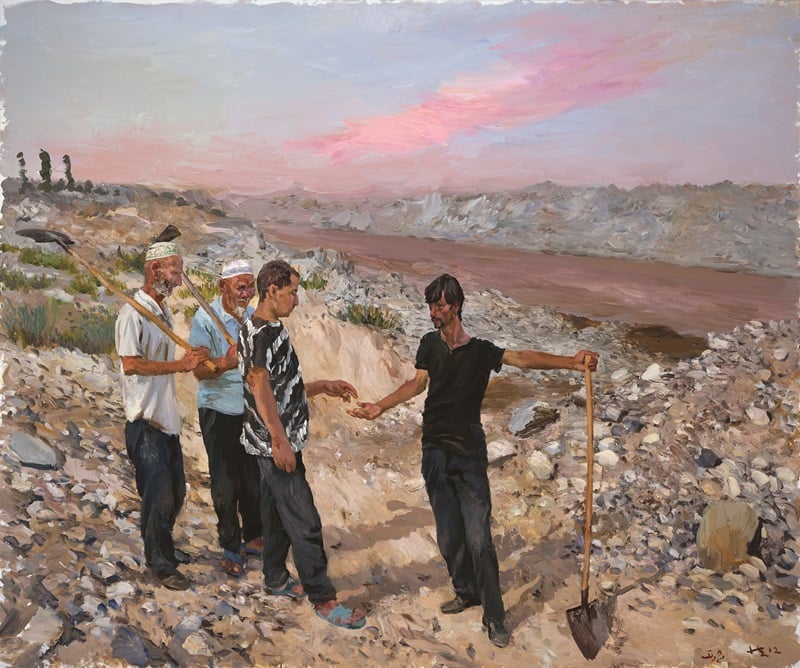Art Fairs
Contemporary Chinese Artist Liu Xiaodong Talks About Mega-Canvas at the Armory Show

Photo: © the artist; Courtesy, Lisson Gallery, London.

Jessica Zhang


Liu Xiaodong, East (2012), oil on canvas, 250 x 300 cm
Photo: © the artist; Courtesy, Lisson Gallery, London.
In honor of the Armory Show’s special focus on China this year, Lisson Gallery is showing a major work, East (2012), by Chinese contemporary artist Liu Xiaodong. This monumental canvas is one of four works from Xiaodong’s The Hotan Project (2012–13), painted in a remote part of Western China in the jade mining region of Xinjiang Province.
Social observation and critique are at the heart of Xiaodong’s work. His vignettes of modern Chinese life provide glimpses of a country in the midst of becoming a world power. This week, Liu responded to artnet via email about some of his ideas behind The Hotan Project.
Jessica Zhang: At this year’s Armory Show, Lisson Gallery is displaying East from your “Liu Xiaodong in Hotan” oil painting series. Why are the four paintings of the series divided into North, South, East, and West?
Liu Xiaodong: In the desert sandstorms, I was unable to differentiate between North, South, East, and West—all of the directions were a sky full of yellow sand.
JZ: Compared to your previous projects, such as the Three Gorges Project, the Qinghai Project, and the Jincheng Project, the Hotan Project is more complex (including not only a documentary about the project, but also publications and such activities as seminars). The Hotan Project is no longer just an artwork; it’s a large, complex artistic project—even a social project. Could you please say more about what led to you to produce this work? And did the outcome of this project match your expectations?
LX: The reason the plans in Hotan were more complex than in other projects was due to the fact that not only were there social problems [to be faced], but also complicated relations between religious and ethnic groups. Over 1,000 years ago, Hotan was considered sacred Buddhist land. Today, 1,000 years later, this is an important region in the Islamic faith. Many different ethnic and religious groups live in the same country, and the differences between them are subtly complicated. Interestingly, these complications are merely a concentration of problems seen on a global scale.
JZ: “On-site painting” is a way of painting from life that presents a realistic style without many hidden meanings or metaphors. It has also been your artistic style since the 1980s. Why have you been so persistent about realism? Have your techniques and perceptions been changing over time?
LX: Every artist needs to seek the most suitable means of expression. For me, painting from life is most naturally produced. I like it, and also think it’s freeing. I believe that the attainability of an artist’s vision is significant. I only sketch my vision that is attainable—within a natural landscape, in someone else’s life, as it is the production of these works that is incredible to me. They’re remarkably mysterious. This makes my artistic views even more open, namely having more association with other people.
JZ: When did you begin to practice on-site painting, or painting in the open (known in Chinese as “xie-sheng”)? Why did you choose on-site painting for the Hotan Project? What’s the biggest difference between painting on-site and painting in a studio?
LX: The year 2004 was the first time I left the country to paint the barracks of soldiers on the mainland and in Taiwan. Then, in 2004, the barracks were standing in an open field. Generally speaking, painting is “killed by light”—all paintings are not nice to look at under direct sunlight. Rather, paintings usually need interior lighting to be enjoyed. The outdoor exhibit made me reject the conventionality of studio painting, and made me [paint] with a freer state of mind and mode of expression.
JZ: How did realist techniques influence your perspective regarding your going to Israel to paint? What about your attitude toward the conflict between Israel and Palestine? Did the recent trips make you favor one population over another?
LX: The Israeli-Palestinian conflict is more complicated and also more direct than I had thought. Regardless of history and today’s territorial disputes, they both want to live well. While facing religion, territory, and ethical issues, the judgments of anyone not living there is powerless. My attainable vision can only go so far.
JZ: In general, do you find that collectors in the East versus those in the West respond differently to your work?
LX: Western and Eastern collectors have equally collected my works. Western collectors seem to be more willing to collect works of mine with Chinese subject matter, whereas Eastern collectors don’t really care for these—they care more for the fact that I’ve personally painted the paintings. Also, Western collectors want to see more Chinese stories, whereas Eastern collectors already understand [the stories] and rather enjoy more my painting style.
JZ: What are you currently working on? Are you planning any trips in the near future?
LX: I’m reluctant to discuss upcoming projects for fear that they won’t happen.